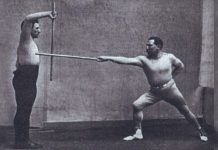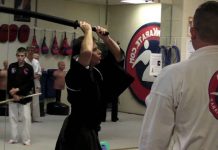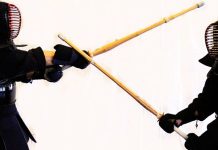Kenjutsu (swordfighting) along with Iaijutsu, comprise the basic principles of swordsmanship. Kenjutsu is the offensive, aggressive art of the sword, whereas Iaijutsu is more defensive in nature. Kenjutsu is the forerunner of Kendo; it was outlawed in 1876, when wearing swords was banned. Schools of Kenjutsu flourished from the ninth century on. Ten centuries later, hundreds of Kenjutsu schools were still in operation. Masters and students continually attempted to improve their techniques, adapting the methods of other schools if they proved effective. As might be expected, numerous personal battles were fought among students and teachers of different schools, to prove whose method was superior. Of all the sword arts, Kenjutsu is the one that most closely resembles European fencing, emphasizing as it does cuts, thrusts and parries. There are also clear target areas. To wound an opponent in a non-target area was considered unworthy. Over time, Kenjutsu developed into the art of Kendo.
Today, only a few schools remain of the original hundreds. Some of the more important schools include Emmei-ryu, Gan-ryu, Hasegawa, Hokushin Itto-ryu, Itto-ryu, Jigen-ryu, Jikishen Kage-ryu, Kage-ryu, Kanemake-ryu, Katori-ryu, Kumi-tachi, Muji Shinden, Muto-ryu, Nakanishi-ha?itto-ryu, Nikaido-ryu, Okuyama-ryu, Shingen-ryu, Taisharyu, Tomita-ryu, Yagyu-ryu and Yoshin-ryu. See Kendo. See Bugei.
From The Martial Arts Encyclopedia by Jennifer Lawler










